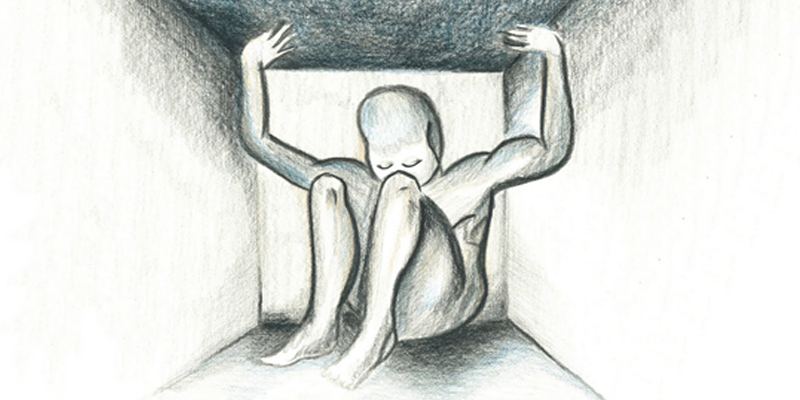Any person would feel a little uncomfortable when put in a closed room or a crowded metro. But, if a person is claustrophobic, he/she would feel constant anxiety and fear of being in such spaces. In fact, the person would be concerned and distressed prior to any such anticipated event in an enclosed place.
Claustrophobia is word derived from Latin word “claustrum” which means lock or bolt. This is a phobia signified by excessive and irrational fear of being in an enclosed and confined space, and not being able to escape from there. Almost all times, being in any such confined spaces possess no risk but the person with claustrophobia would feel extremely vulnerable in such places. Places like elevators, airplanes, tunnels, caves, small rooms or room without windows, roller coasters, public toilets, MRI or crowded subways can cause claustrophobia in people.

How common is claustrophobia?
Claustrophobia is one of the very common phobias existing globally. Studies show that 15 to 37 percent of people have claustrophobia worldwide. 5 percent people of the U.S. and 10 percent of the U.K are suffering from claustrophobia. It has been seen that women are more likely to be claustrophobic than men. It can occur with all age groups.
What Causes claustrophobia?
Several factors seen to cause claustrophobia in people are
Traumatic events
Claustrophobia is very likely to occur if the person has faced harmful and life-threatening situations in confined spaces previously. It can be events like getting trapped in a closet or bathroom, getting stuck in an elevator, accidents associated with train or airplanes or getting drowned in a pool.
Evolutionary survival mechanism
It has seen that the fear can be a resultant of the dormant evolutionary feature of human beings. The fear and anxiety of being in confined spaces is an in-built genetic feature of human being since early civilizations. Such dormant fear was used for defense against any danger during early civilizations, but now not necessary. It can take a form of phobia when confronted with resembling situations at present time.
Depression
A person is very much vulnerable to claustrophobia if he/she has some sort of other depressive disorders like Generalized Anxiety Disorder, Social phobia or panic disorder. Such disorder may aggravate the feeling of need to escape from any space with people in them, and may make them claustrophobic.
What are the symptoms of claustrophobia?
Common symptoms that can occur with both children and adults when they’re in enclosed places are:
- Feeling of extreme fear and dread for no reason
- Feeling of helplessness and unable to escape
- Getting detached from the reality
- Trying to avoid any confined spaces like elevators, clothing trial rooms or public toilets as much as possible
- Anger and trying to combat whenever put in any enclosed place
- Panic attack accompanied by signs such as trembling, trouble in breathing, dizziness and fainting, sweating, nausea and vomiting, numbness around limbs, abdominal uneasiness, racing heartbeat and chest pain
When to see a doctor?
You need to seek help from doctor if the symptoms have been occurring for long time period exceeding at least six months. Moreover, if the phobia prolongs and reaches severity, your daily life may be disrupted completely as you may start avoiding even bathrooms and your car. In such circumstance, you need to start with a treatment process immediately.
How is claustrophobia treated?
Claustrophobia can be treated using a series of therapies and medicines. Most effective treatment methods include:
Cognitive Behavioral therapy (CBT)
CBT is aimed at discovering the underlying cause and thoughts associated with the fear of being in such confined spaces. Through regular counseling, the therapist and the person has extensive sharing sessions and helps the person release the burden that has been causing the fear. It is aimed at replacing the negative images and thoughts encircling the phobia with positive thoughts.
Hypnotherapy
Hypnotherapy may also be used by a therapist to make the person remember and become aware of any related traumatic event related to the fear of being in confined spaces. The therapist guides through visualizations and helps the person see the traumatic moments through the eyes of an adult man. This will eventually help to implant toleration in the person.
Exposure Therapy
Exposure therapy is another effective therapy where the person is exposed to situations in confined spaces. The therapist studies the reaction of the person, and teaches the person to confront the fear effectively during such exposures. For this, the therapist teaches several ways to relax such as breathing control, muscle control and meditations. Through regular exposures and relaxation, the fear is reduced steadily.
Medicines
Medicines are also used to bring down the symptoms of fear and anxiety that can cause a lot of mental distress. Commonly used medicines are anti-anxiety and anti-depressant drugs which help to control the feelings of apprehension.